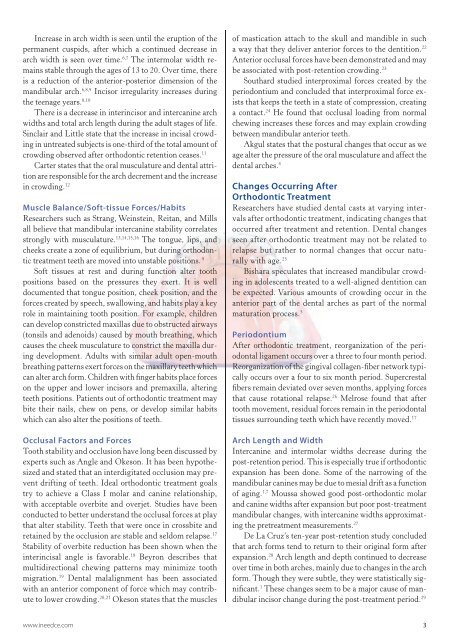Indefinite Orthodontic Retention - IneedCE.com
Indefinite Orthodontic Retention - IneedCE.com
Indefinite Orthodontic Retention - IneedCE.com
You also want an ePaper? Increase the reach of your titles
YUMPU automatically turns print PDFs into web optimized ePapers that Google loves.
Increase in arch width is seen until the eruption of the<br />
permanent cuspids, after which a continued decrease in<br />
arch width is seen over time. 6,7 The intermolar width remains<br />
stable through the ages of 13 to 20. Over time, there<br />
is a reduction of the anterior-posterior dimension of the<br />
mandibular arch. 6,8,9 Incisor irregularity increases during<br />
the teenage years. 8,10<br />
There is a decrease in interincisor and intercanine arch<br />
widths and total arch length during the adult stages of life.<br />
Sinclair and Little state that the increase in incisal crowding<br />
in untreated subjects is one-third of the total amount of<br />
crowding observed after orthodontic retention ceases. 11<br />
Carter states that the oral musculature and dental attrition<br />
are responsible for the arch decrement and the increase<br />
in crowding. 12<br />
Muscle Balance/Soft-tissue Forces/Habits<br />
Researchers such as Strang, Weinstein, Reitan, and Mills<br />
all believe that mandibular intercanine stability correlates<br />
strongly with musculature. 13,14,15,16 The tongue, lips, and<br />
cheeks create a zone of equilibrium, but during orthodontic<br />
treatment teeth are moved into unstable positions. 9<br />
Soft tissues at rest and during function alter tooth<br />
positions based on the pressures they exert. It is well<br />
documented that tongue position, cheek position, and the<br />
forces created by speech, swallowing, and habits play a key<br />
role in maintaining tooth position. For example, children<br />
can develop constricted maxillas due to obstructed airways<br />
(tonsils and adenoids) caused by mouth breathing, which<br />
causes the cheek musculature to constrict the maxilla during<br />
development. Adults with similar adult open-mouth<br />
breathing patterns exert forces on the maxillary teeth which<br />
can alter arch form. Children with finger habits place forces<br />
on the upper and lower incisors and premaxilla, altering<br />
teeth positions. Patients out of orthodontic treatment may<br />
bite their nails, chew on pens, or develop similar habits<br />
which can also alter the positions of teeth.<br />
Occlusal Factors and Forces<br />
Tooth stability and occlusion have long been discussed by<br />
experts such as Angle and Okeson. It has been hypothesized<br />
and stated that an interdigitated occlusion may prevent<br />
drifting of teeth. Ideal orthodontic treatment goals<br />
try to achieve a Class I molar and canine relationship,<br />
with acceptable overbite and overjet. Studies have been<br />
conducted to better understand the occlusal forces at play<br />
that alter stability. Teeth that were once in crossbite and<br />
retained by the occlusion are stable and seldom relapse. 17<br />
Stability of overbite reduction has been shown when the<br />
interincisal angle is favorable. 18 Beyron describes that<br />
multidirectional chewing patterns may minimize tooth<br />
migration. 19 Dental malalignment has been associated<br />
with an anterior <strong>com</strong>ponent of force which may contribute<br />
to lower crowding. 20,21 Okeson states that the muscles<br />
of mastication attach to the skull and mandible in such<br />
a way that they deliver anterior forces to the dentition. 22<br />
Anterior occlusal forces have been demonstrated and may<br />
be associated with post-retention crowding. 23<br />
Southard studied interproximal forces created by the<br />
periodontium and concluded that interproximal force exists<br />
that keeps the teeth in a state of <strong>com</strong>pression, creating<br />
a contact. 24 He found that occlusal loading from normal<br />
chewing increases these forces and may explain crowding<br />
between mandibular anterior teeth.<br />
Akgul states that the postural changes that occur as we<br />
age alter the pressure of the oral musculature and affect the<br />
dental arches. 4<br />
Changes Occurring After<br />
<strong>Orthodontic</strong> Treatment<br />
Researchers have studied dental casts at varying intervals<br />
after orthodontic treatment, indicating changes that<br />
occurred after treatment and retention. Dental changes<br />
seen after orthodontic treatment may not be related to<br />
relapse but rather to normal changes that occur naturally<br />
with age. 25<br />
Bishara speculates that increased mandibular crowding<br />
in adolescents treated to a well-aligned dentition can<br />
be expected. Various amounts of crowding occur in the<br />
anterior part of the dental arches as part of the normal<br />
maturation process. 5<br />
Periodontium<br />
After orthodontic treatment, reorganization of the periodontal<br />
ligament occurs over a three to four month period.<br />
Reorganization of the gingival collagen-fiber network typically<br />
occurs over a four to six month period. Supercrestal<br />
fibers remain deviated over seven months, applying forces<br />
that cause rotational relapse. 26 Melrose found that after<br />
tooth movement, residual forces remain in the periodontal<br />
tissues surrounding teeth which have recently moved. 17<br />
Arch Length and Width<br />
Intercanine and intermolar widths decrease during the<br />
post-retention period. This is especially true if orthodontic<br />
expansion has been done. Some of the narrowing of the<br />
mandibular canines may be due to mesial drift as a function<br />
of aging. 1,7 Moussa showed good post-orthodontic molar<br />
and canine widths after expansion but poor post-treatment<br />
mandibular changes, with intercanine widths approximating<br />
the pretreatment measurements. 27<br />
De La Cruz’s ten-year post-retention study concluded<br />
that arch forms tend to return to their original form after<br />
expansion. 28 Arch length and depth continued to decrease<br />
over time in both arches, mainly due to changes in the arch<br />
form. Though they were subtle, they were statistically significant.<br />
1 These changes seem to be a major cause of mandibular<br />
incisor change during the post-treatment period. 29<br />
www.ineedce.<strong>com</strong> 3

















